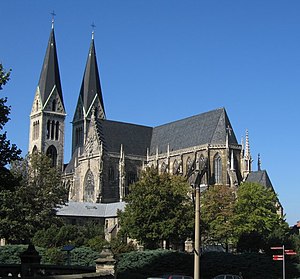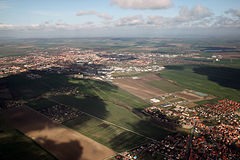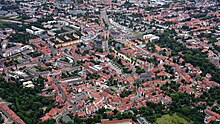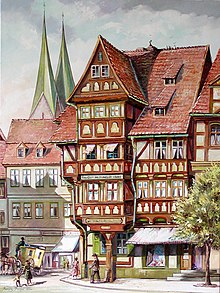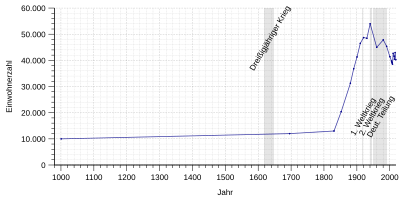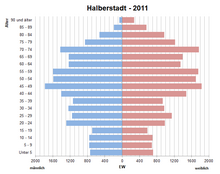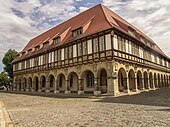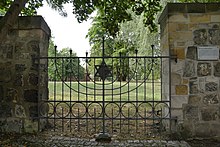Halberstadt
| coat of arms | Germany map | |
|---|---|---|

|
Coordinates: 51 ° 54 ' N , 11 ° 3' E |
|
| Basic data | ||
| State : | Saxony-Anhalt | |
| County : | resin | |
| Height : | 122 m above sea level NHN | |
| Area : | 142.98 km 2 | |
| Residents: | 40,329 (Dec. 31, 2019) | |
| Population density : | 282 inhabitants per km 2 | |
| Postcodes : | 38820, 38822, 38895 | |
| Primaries : | 03941, 039424, 039425, 039427 | |
| License plate : | HZ, HBS, QLB, WR | |
| Community key : | 15 0 85 135 | |
| LOCODE : | DE HST | |
| NUTS : | DEE09 | |
| City structure: | 10 districts | |
City administration address : |
Holzmarkt 1 38820 Halberstadt |
|
| Website : | ||
| Lord Mayor : | Andreas Henke ( The Left ) | |
| Location of the district town of Halberstadt in the Harz district | ||
Halberstadt ( Low German Halwerstidde ) is the district town of the Harz district in Saxony-Anhalt (Germany). The city is located in the northern Harz foreland . The inner city was destroyed to more than 80% by an air raid on April 8, 1945 . It was then rebuilt or rebuilt over decades.
geography
Halberstadt is around 20 kilometers north of the Harz on the Holtemme and Goldbach . To the north of the city is the Huy ridge , to the east the Magdeburger Börde and to the south the mountains of mirrors , bars and Klusberge . With around 43,000 inhabitants, Halberstadt is the largest city in the Harz district.
City structure
In addition to the core city, the city of Halberstadt consists of the following districts with a local council:
Further districts are:
- Böhnshausen
- Mahndorf
- New Runstedt
- Veltensmühle
The districts of Böhnshausen and Mahndorf belong to the locality of Langenstein.
In addition, there are the following three districts:
- Wehrstedt (incorporated July 1, 1946),
- Klussiedlung and
- Sargstedter settlement
Neighboring communities
Clockwise, starting from the north:
- Huy parish
- City of Schwanebeck and the community of Groß Quenstedt (both Vorharz association )
- City of Gröningen ( Verbandsgemeinde Westliche Börde in the district of Börde )
- City of Wegeleben and Harsleben municipality (both Vorharz association )
- City of Thale
- City of Blankenburg (Harz)
- North Harz municipality
- City of Osterwieck
climate
The city is located in the temperate climate zone . The average annual rainfall in Halberstadt is 542 millimeters. Most of the precipitation falls in June with an average of 69 millimeters, the lowest in February with an average of 31 millimeters. Average temperatures range between 0.2 ° C in January, which is the coldest month, and 17.6 ° C in July, which is the warmest.
|
Average monthly temperatures and precipitation for Halberstadt
Source:
|
||||||||||||||||||||||||||||||||||||||||||||||||||||||||||||||||||||||||||||||||||||||||||
history
Early farming settlement (around 5000 BC)
In 2013 a mass grave was discovered in Halberstadt that dates back to the same time as other well-known sites where massacres or executions took place, such as Herxheim or Talheim , Wiederstedt or Schöneck-Kilianstädten in Germany and Asparn / Schletz in Austria. In Halberstadt, young men were apparently killed and then buried in a mass grave. According to the excavators, it is conceivable that the men who came from some distance from the village were attackers themselves, but who had failed in their attack.
From the foundation to 1900
The origin of the name Halwerstidde (or Halverstidde ) "requires a thorough, yet to be carried out investigation". A relationship to halba ( ahd. Side, half) or a river section name Halver der Holtemme is assumed.
By Charlemagne the mission base 804 became the bishop's seat . The Bishop Hildeward of Halberstadt (968-996) was 989 by King Otto III. the market, coin and customs rights conferred. He also received the ban on blood and army, that is, secular power in the Harzgau and thus over the residents of Halberstadt. In 1005 the construction of the Liebfrauenkirche began . Heinrich the Lion destroyed the city, cathedral and cathedral castle in 1179. In 1192 the Templars came to Halberstadt and founded a commander in the Burchardi monastery . In 1236 the new construction of the cathedral began, which was consecrated in 1491. A few years before 1297 the mendicant order of the Servites came to Halberstadt and founded a monastery in the New City in front of the water gate.
In 1326 the city merged with Aschersleben and Quedlinburg until 1477 to form the Halberstadt Tri- City Alliance . In 1387 Halberstadt also joined the Hanseatic League . In 1433 the city roland was set up .
The Protestant doctrine was introduced at Halberstadt Cathedral in 1591 by the first Protestant Bishop of Halberstadt, Heinrich Julius . But until the end of the Thirty Years' War there was a mixed denominational cathedral chapter .
During the witch hunts , around 24 people in Halberstadt were sentenced to death in witch trials . During this time, the Evangelical lawyer and diplomat Justus Oldekop (1597–1667) worked in Halberstadt from 1650 to 1660 as the syndic of the estates . He was an early enlightenment officer and, two years after Friedrich Spee, advocated a much more humane penal system in German (and not anonymously in Latin). He also referred to witch trials.
In 1629 there was a second occupation of Halberstadt by Wallenstein's troops . With the help of the Edict of Restitution, the imperial commander-in-chief made the cathedral and Liebfrauenstift Catholic again for a short time . On January 18, 1630, Wallenstein was personally in Halberstadt. The prince-bishopric of Halberstadt became part of Brandenburg-Prussia in 1648 as the duchy . In the years 1681/82 the plague raged in the city. 2197 people died from it.
From around 1750 the cathedral secretary Johann Wilhelm Ludwig Gleim turned his house into a communication center for the German Enlightenment (largest original library and collection of letters on the German Enlightenment in the Gleimhaus , now Germany's second oldest literary museum). There was also the Halberstadt Literary Society from 1785 to 1810 .
In 1761, the mirror mountains were acquired by Ernst Ludwig Christoph von Spiegel and redesigned into a landscape park. In 1778 Friedrich Eberhard von Rochow founded Germany's first rural school teacher seminar in Halberstadt. In 1807 Halberstadt became part of the Kingdom of Westphalia created by Napoleon and the seat of a prefecture and capital of the Saale department. In the fifth coalition war, in a bloody battle on July 29, 1809, the black crowd of the Duke of Braunschweig conquered the city and moved on with 2,000 prisoners.
After the Congress of Vienna, Halberstadt returned to Prussia and became part of the new province of Saxony . As part of the district formation in the administrative district of Magdeburg , the city district of Halberstadt was set up in 1816 , which included the town itself as well as the surrounding villages. The urban district of Halberstadt was expanded in 1825 to include parts of the districts of Oschersleben and Osterwieck and converted into a normal district with Halberstadt as the district town .
With the opening of the railway line to Magdeburg by the Magdeburg-Halberstädter Eisenbahn in 1843, Halberstadt was connected to the constantly expanding railway network. Friedrich Heine founded the Halberstadt sausage factory in 1883 . The bathing establishment was established in 1890. The first German trade union congress took place in Halberstadt in 1892. In 1891 Halberstadt left the district and again formed its own urban district.
1900 until today
In 1903 Halberstadt received an electric tram . The city theater and the city museum were founded in 1905. As early as 1812 there had been one of the first civic speaking theaters in Germany in the former Nicolaikloster.
From 1912, the German Bristol Works in Halberstadt built aircraft. During the First World War , the former German-British joint venture, renamed Halberstädter Flugzeugwerke , produced aircraft for the air force of the German Army . After the war ended in November 1918 had due to the conditions of the contracts of Versailles of aircraft in the German Reich of the Weimar Republic are all set and now the Berlin-Halberstadt industry Werke AG belonging to former aircraft factory was the beginning of 1926 in the bankruptcy .
As part of the armament of the Wehrmacht , a branch of the Dessau Junkers aircraft factory was put into operation in 1935 on part of the former factory premises in Halberstädter Klusstraße 30-38 , which manufactured wings for the Ju 88 . This plant was the target of American bombers several times during World War II . (→ Big Week ).
The synagogue in Bakenstrasse, donated by court Jew Berend Lehmann in 1712 with its baroque architectural style, was one of the most beautiful in Europe at the time it was built. During the pogrom night of November 9, 1938 , it was looted by the National Socialists and all Torah scrolls were burned on the street. Since it was closely integrated into the existing half-timbered buildings, arson was avoided and the Jewish community was forced to demolish its synagogue with their own hands. On November 23, 1942, the last remaining members of the Jewish community were deported.
During the Second World War, the SS set up several subcamps in the city , including a subcamp of the Buchenwald concentration camp in 1944 in the Junkers factory on Harslebener Strasse for 400 to 900 prisoners who had to perform forced labor there . A satellite camp of the Langenstein-Zwieberge concentration camp existed below the Wehrstedter Bridge in the Reichsbahnausbesserungswerk (RAW), where up to 200 prisoners were deployed.
On April 8, 1945, 218 American bombers of the 1st Air Division of the 8th Air Force of the type B-17 "Flying Fortress" with 595 tons of high explosive and incendiary bombs destroyed 82 percent of the city center in a devastating area bombing . On that day 239 escort fighters escorted the 1st Air Division, whose main target was Halberstadt. Around 2,500 people were killed in the attack. The amount of debris was about 1.5 million cubic meters. Just three days later, on April 11th, American ground forces occupied the city. On May 18, the Americans surrendered the city to the British and at the end of June 1945 the latter to the Red Army . Halberstadt became part of the SBZ and, from 1949, the GDR .
From 1949 to 1989, the inner city, which was largely destroyed, was partly rebuilt and rebuilt in a “socialist way of building”; the remaining half-timbered houses in the old town were planned to be abandoned to decay and large areas were torn down. The ruins of the Romanesque-Gothic Paulskirche were also removed. At the turn of 1989 only small parts of the old town existed.
In 1989 prayers for peace were held in the Martini Church. Thousands of citizens gathered in autumn that year under the motto “ Swords to Plowshares ”. Demonstrations took place from the church, which also initiated the peaceful political turnaround in Halberstadt . One demand was the completion of demolition work in the city center. A simple memorial on the tower side of the church commemorates these events.
After 1990, the rest of the old town was restored and, from 1995, a modern city center was built on the foundation walls and the scale of the historic town center. The new city center in the area of the marketplaces was completed in 1998 with the construction of the new town hall.
On June 8, 2007, an attack on a troupe of actors caused a nationwide sensation, in which five actors were so injured that they had to be admitted to the Halberstadt clinic. The police failed to record the perpetrators' personal details, even though they were still at the scene. Four of the perpetrators, who belonged to the right-wing extremist scene, received only extremely mild court judgments.
On September 23, 2008, the city received the title “ Place of Diversity ” awarded by the federal government .
military
From 1623 to 1994 Halberstadt was garrison town almost continuously for 372 years .
From 1815 to 1919 Halberstadt was the garrison of the Halberstadt cuirassiers ( cuirassier regiment "von Seydlitz" (Magdeburgisches) No. 7 ). The most prominent member of the regiment was the later Chancellor Otto von Bismarck , who often wore the uniform of this unit, and so appears in Anton von Werner's painting The Proclamation of the German Empire (January 18, 1871) .
An airfield with flight school was created south of the city before and during the First World War. In 1913 the Halberstadt aircraft factory was established. Both had to be dismantled after the war.
During the Weimar Republic , the regimental staff and the training battalion of the 12th Infantry Regiment of the Reichswehr were stationed in Halberstadt . This was in the Prinz-Ferdinand-Kaserne on Harmoniestraße. There was also the Bismarck barracks in the Kürassierstraße with the artillery regiment 4 and the on-site hospital on the Quedlinburger Straße.
From 1935 there was an air force garrison in Halberstadt. The "Air Base Barracks" was built at the air base. In 1944 the facilities were damaged by bombing raids .
From April to May 1945 there was an American and from May to June a British garrison in Halberstadt.
During the GDR era, GSSD troops were stationed in Halberstadt (for example the 197th Armored Guard Regiment and 112th Reconnaissance Battalion). These troop units, all subordinate to the 3rd shock army (see: Structure of the WGT 1991 ), were in the garrison of the former air base barracks. The site also included a site training area with armored firing ranges.
The barracks are still fallow today, the buildings formerly used by the Soviet Army have now been almost completely demolished. The Martin-Schwantes barracks, which until 1990 was the seat of the GDR border troops (including border regiment 20), has also been demolished . Part of the site is now used by the Federal Agency for Technical Relief , among others . The Martin Hoop barracks , former training barracks for the border troops (Grenzausbildungsregiment 7), is now home to the central contact point for asylum seekers in Saxony-Anhalt, including accommodation options.
On December 29, 1994 was Air Force Material Depot 52 of the Federal Armed Forces , located in the former underground facility (UTA) and tunnel system was MALACHIT near Langenstein and so 1989/1990 the complex bearing 12 (malachite) of the NVA took dissolved. This ended the garrison history of Halberstadt after 371 years.
Evidence of the former garrison town of Halberstadt can still be found in the urban area. These include the Ebereschenhof (largely demolished), the grounds of the district administration and Florian-Geyer-Straße.
Incorporations
On May 1, 1995 Emersleben was incorporated. On January 1, 1996, Klein Quenstedt was added. Aspenstedt, Athenstedt, Langenstein, Sargstedt and the chess village Ströbeck have been part of Halberstadt since January 1st, 2010.
Population development
|
|
politics
Lord Mayor
Mayor of Halberstadt is Andreas Henke ( Die Linke ), who was elected on September 1, 2013 in the first ballot with 53.65% of the vote. The CDU candidate Daniel Szarata received 34% of the vote in this election. Only 8.94% voted for Peter Köpke (SPD). The non-party Volkmar Hofmann achieved a share of the vote of 3.41%. The turnout was 39.8%.
In the previous election in 2006, Henke had to face a runoff against the SPD candidate Hans-Georg Busch, but clearly won it with 72.5% of the votes cast. At that time, Henke received 34.25%, Busch 33.6%, Hans-Joachim Purfürst (CDU) 28.65% and Detlef Schulz 3.49% of the vote in the first ballot. Only a third of the eligible voters took part in both ballots.
City council
The result of the local elections on May 26, 2019 , the distribution of the 40 seats in the city council and the voter turnout are shown below (with comparative figures from the two previous elections). The turnout was 47.71% (2014: 35.3%).
| Party / list | Share of votes | Seats | 2014 | 2009 | |
|---|---|---|---|---|---|
| CDU | 30.46% | 12 | 40.0%, 16 seats | 30.4%, 12 seats | |
| The left | 18.31% | 7th | 22.2%, 9 seats | 25.7%, 10 seats | |
| AfD | 13.44% | 5 | - | - | |
| SPD | 9.85% | 4th | 12.7%, 5 seats | 11.9%, 5 seats | |
| Citizens of our district without a party membership (BUKO) | 8.53% | 3 | 6.9%, 3 seats | - | |
| Alliance 90 / The Greens | 6.96% | 3 | 3.7%, 1 seat | 2.6%, 1 seat | |
| Free voters (FW) | 6.64% | 3 | - | - | |
| FDP | 4.33% | 2 | 2.0%, 1 seat | 3.2%, 1 seat | |
| Emersleben Community of Voters (EEC) | 1.48% | 1 | 1.6%, 0 seats | - | |
| voter turnout | 47.71% | 35.3% | 33.6% | ||
coat of arms
The coat of arms shows a wolf tang and the original colors of the Halberstadt diocese .
Blazon : "Split of silver and red, covered with an oblique black double hook."
The right half of the coat of arms (silver / white) stands for the bourgeoisie. The left half of the coat of arms (red) stands for the clergy. The wolf tang or double hook (either construction clamps for half-timbered beams or kettle hooks for the hearth fire) symbolizes the cohesion of both. The coat of arms says that the bishops were not only spiritual shepherds, but also warlords.
Town twinning
Halberstadt maintains city partnerships with
-
 Wolfsburg in Germany , since 1989
Wolfsburg in Germany , since 1989 -
 Banská Bystrica in Slovakia , since 1998
Banská Bystrica in Slovakia , since 1998 -
 Náchod in the Czech Republic , since 1998
Náchod in the Czech Republic , since 1998 -
 Villars in France , since 2003
Villars in France , since 2003
Asylum seekers
The only central contact point for asylum seekers (ZASt) in Saxony-Anhalt is located in Halberstadt.
Culture and sights
theatre
The city theater, which burned out in the air raid on April 8, 1945, was torn down in 1949 and replaced by the newly built "Volkstheater". Today the Nordharzer Städtebundtheater plays in the large house as well as the chamber stage and the small "Alte Kantine" theater, as well as the stages in Quedlinburg and the Thale mountain theater as well as other theaters in the region.
Museums
The Heineanum is one of the largest ornithological museums in Germany with over 18,000 bellows , more than half of all bird species , including rare extinct specimens. The Gleimhaus is one of the oldest literary museums in Germany . There is also the Städtisches Museum, the Berend-Lehmann-Museum for Jewish history and culture, the cathedral and the cathedral treasure as well as the screw museum, in which civil living culture around 1900 is exhibited. The reopening of the cathedral treasure was celebrated on April 13, 2008 with a festive service, among others with Federal President Horst Köhler .
music
In addition to the Nordharzer Städtebundtheater (three-branch theater with large and small stages), the organ work ORGAN² / ASLSP by John Cage (1912–1992) with a total playing time of 639 years has been performed in the St. Burchardi Church since 2001 . The performance is conceived as the slowest and longest-lasting piece of music in the world, in that the eight-page score was extrapolated to the desired playing time. Since 2012, the Gröninger organ in St. Martini has been reconstructed by David Beck from 1596, the prospectus of which is still preserved.
Buildings

The most important buildings in Halberstadt are located on Domplatz, a historical ensemble bordered by the cathedral to the east and the Church of Our Lady to the west. On the north side are the historic Canon Curia , which today houses the City Museum, the Dombauhütte, the Heineanum and the Gleimhaus . To the south are the former cathedral grammar school and the cathedral provost , both of which belong to the Harz University of Applied Sciences , as well as the neo-Romanesque post office. On the northwest side are the Petershof and the Peterstreppe . The cultural monuments of Halberstadt are listed in the Halberstadt register of monuments.
- The Petershof is a former bishop's palace, construction began around 1059. After the renovation, the Petershof is the seat of the city administration and the Heinrich Heine city library .
- The historic old town is limited to the preserved streets of Voigtei, Bakenstraße, Gröperstraße, Rosenwinkel, Grudenberg, Grauer Hof, Steinhof and Westendorf. It consists of around 450 houses, mainly built in the Lower Saxony half-timbered style.
- The town hall is a new building with reconstruction of parts of the facade and the council arbor of the previous building which was destroyed in the war. The statue of Roland stands in front of the building . Since 2004, there has been a new porcelain carillon made of Meissen porcelain with 25 bells on the west facade of the town hall .
- The water gate tower was built in 1444 and is the only surviving gate tower in Halberstadt.
- The Bismarck Tower , inaugurated on March 22, 1907, is a 22 m high observation tower. It is located on the western edge of the Spiegelberg Mountains and was built in memory of Chancellor Otto von Bismarck .
- The Belvedere observation tower is also located on the Spiegelbergs.
- The oldest and largest surviving wine barrel in Germany with a capacity of around 144,000 liters is stored in the Spiegelsberge hunting lodge .
- The Klaussynagoge in Rosenwinkel was built by Berend Lehmann in 1703 as a residential and study house for three Jewish scholars. Today this building is part of the Moses Mendelssohn Academy and is used for conferences and exhibitions.
- Villa Koecher , built in 1879, is a historicist villa in Italian style with a cast iron banister. It is a listed building. During the GDR era, the building was used, among other things, as the seat of the NDPD district executive .
- The Villa Magdeburger Straße 37 is a listed building. It was built in 1861 as a typical late classicist building by order of the factory owner Gölte and is of particular importance as one of the few villas in the Wilhelminian eastern expansion of the city that remained after the destruction of the war .
Churches
(see also religions )
- The St. Stephen and St. Sixtus Cathedral is one of the most important Gothic cathedrals in Germany. Construction began in 1236 and was consecrated in 1491 after 255 years. The Halberstadt Cathedral Treasure is considered one of the most precious treasures of sacred medieval art around the world.
- The winter church in the early Gothic west wing of the cathedral enclosure, Domplatz 16a, Halberstadt. The Winter Church has had a new organ by Reinhard Hüfken since 2002.
- The Liebfrauenkirche was built in 1146. It is a four-tower Romanesque pillar basilica that is unique in central and northern Germany .
- The Martinikirche was built between 1250 and 1350. The Gothic hall church has a massive double tower facade. The northern tower was deliberately built lower in order to give the guard in the southern tower an all-round view.
- The St. Moritz Church , built around 1246, is a three-aisled pillar basilica.
- The Burchardikirche was built around 1210. It is a Romanesque, towerless basilica with a rare, rectangular ambulatory choir, in which John Cage's organ piece As slow as possible has been performed since 2001 .
- The St. Andrew's Church was built in the 13th century as part of the Franciscan monastery built and is a turretless Gothic church.
- St. John's Church , completed in 1648, is a half-timbered church with a polygonal choir closure and Gothic windows.
- The Church of St. Catherine, consecrated to St. Catherine and St. Barbara, was built in the 14th century. The three-aisled, towerless hall church, until 1810 the Dominican monastery church, is now a Catholic parish church.
- The St. Laurentius Church was built around 1194 and is a Romanesque village church in the Wehrstedt district. The ruins of the church, which was destroyed in World War II, were rebuilt on the remains of the old wall in just 60 hours in 1993 in a spectacular action by the ARD television program “Jetzt oder nie”.
- The chapel in the camp of the Zionsgemeinde , Am Johannesbrunnen 36, Halberstadt
General cemeteries
- Mass graves in the main cemetery for the more than 2,000 victims of the bombing raids on Halberstadt in 1944 and 1945, especially on April 8, 1945.
- Mass grave in the main cemetery , which commemorates bomb victims among foreign workers and victims of forced labor .
- Memorial stone for the Italian bomb victims in Halberstadt
- In the cemetery of the district of Emersleben, two collective graves and a single grave commemorate 13 Soviet prisoners of war , nine children of Soviet slave laborers and one slave laborer, who all died under the most miserable living conditions during the Second World War .
- Honor grove for those persecuted by the Nazi regime , where 164 prisoners from the Langenstein-Zwieberge subcamp are buried
- Gravestone on the grave of Minna Bollmann , a member of the social democratic state parliament , who was driven to suicide by the persecution of the National Socialists in 1935
- Family grave of Hans-Georg Klamroth as an accessory to the assassination attempt on July 20, 1944 , murdered in Berlin-Plötzensee
- Memorial stone from 1988 to the Jewish victims of the Shoah
- Collective grave in the cemetery of the Wehrstedt district for eleven Serbian people whose names are unknown and who fell victim to forced labor during the Second World War
- Place of honor at the foot of the Spiegelbergs for 864 Red Army soldiers (559 according to other information) and Soviet prisoners of war as victims of forced labor
- Grave fields in the main cemetery for 403 German soldiers of the First World War and 500 soldiers of the Second World War buried here .
Jewish cemeteries
There are three Jewish cemeteries in Halberstadt :
- The old cemetery on Sternstrasse, on the so-called “Red Stocking”, was laid out in 1644. There are still around 150 weathered tombstones there today . The oldest surviving tombstone dates from 1659. In 1938 the cemetery was desecrated by the National Socialists and some of the tombstones were used for anti-fragmentation trenches. Most of the more than 1,800 gravestones were only used in the spring of 1945 to build anti- tank barriers against the Allies advancing from Braunschweig . In the documents of the city archives there is a tombstone plan from 1945; that is, the gravestones were registered for the purpose of "tank traps".
- At the Am Berge cemetery (opened in 1695) around 400 tombstones can still be found in good condition, including those of deserving personalities such as members of the Hirsch family and Berend Lehmann . This second cemetery was opened in 1696 next to the oldest cemetery. It was occupied until the 1930s.
- The third and youngest cemetery, laid out in 1895, is located on Klein-Quenstedter Chaussee, as part of the municipal cemetery. It is a listed building. In this cemetery there are still 384 grave sites with around 300 gravestones. The “mourning hall” was burned down and blown up during the Reichspogromnacht in 1938, but the graves remained untouched with a few exceptions.
Monuments
- Halberstädter Roland in front of the town hall
- Statue of the poet Anna Louisa Karsch , created in 1784 by JC Stubnitzky in the Spiegelsbergen as the first poet statue in Germany, today with a head supplemented by Daniel Priese in the foyer of the Gleimhaus
- Commemorative plaque on a gym at the Wehrstedter Bridge in memory of 124 victims of forced labor during the Second World War
- Memorial from 1982 at the cathedral for the Jewish victims of the Shoah
- Stones of Remembrance from 1992 by the sculptor Daniel Priese on Domplatz to commemorate all Jews who were killed in Halberstadt
- Showcase at the secondary school "Anne Frank" on Hans-Neupert-Straße to commemorate the life of Anne Frank
- Memorial plaque on the ruins of the police prison in Gerhart-Hauptmann-Strasse to the victims of an early concentration camp
- Ruins of the Franzosenkirche : since 1968 a memorial to the victims of the bombing raids on Halberstadt. On April 8, 1945, around 70 people were killed in the air raid shelter of the former church.
- Memorial (from 2004) in front of the town hall for the rubble women from Halberstadt who cleared away the debris as a result of the bombing of April 8, 1945
- Memorial on the tower side of the Martinikirche in memory of the Peaceful Revolution in Halberstadt in 1989
- Thingstein (Lügenstein, Teufelsstein) from pre-Christian times, near the cathedral entrance. Today's Domplatz was a Germanic Thingstätte.
Leisure and sports facilities
leisure
- Leisure and sports center at the summer pool
- Halberstädter See
- Camping site "Camping am See"
- Cinema (Kinopark Zuckerfabrik)
Parks
- The Halberstadt Mountains include the Bar, Klus and Mirror Mountains . They are located in front of the city to the south and, with a total area of around 400 hectares, form the largest contiguous recreation area in the Harz foreland. The Spiegelsberge landscape park is part of the Garden Dreams Saxony-Anhalt network .
- The Halberstadt zoo has been located in the Spiegel Mountains since 1961 and is home to more than 250 animals of 75 species.
- The plantation is located west of the center and is a park for recreation, in the city center.
- The duck pond is located north of the Bailiwick and is a pond with a park that was created in the Middle Ages, where ducks and swans still live today. In the past, the duck pond was a place of inspiration for poets such as Johann Wilhelm Ludwig Gleim . This is why the path along the pond is also called the Poet's Walk.
Sports facilities
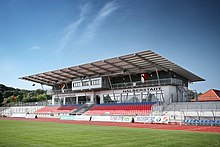
- In Halberstadt there is the Friedensstadion , which is used as the home ground of the regional soccer division VfB Germania Halberstadt , which also includes the athletics departments (four-time German runner-up in the German men's team championship), judo , gymnastics and cheerleading .
- Leisure and sports center
- Sugar Factory Sport Factory
Culinary specialties
The Halberstadt sausages are known as specialty of the city. The Halberstadt sausage was the first sausage in a can worldwide .
Economy and Infrastructure
economy
The Halberstadt economy is shaped by small and medium-sized companies. The city administration has designated three industrial zones and one industrial zone in the east of the city, in which new industrial establishments will be located. The unemployment rate in the district of Harz is (as of September 2019) with 4.7 percent, slightly lower than the average for the state of Saxony-Anhalt (6.7% September 2019).
Well-known national products are the Halberstädter Würstchen from Halberstädter Würstchen- und Konservenvertriebs-GmbH . There are also a number of smaller companies, including mechanical engineering, agricultural machinery, plastics and medical technology (Primed), a furniture factory (HMW) and, as the oldest industrial company, a rubber factory (Teguma). Halberstadt is an administrative location with supra-regional importance.
During the GDR era, the Halberstadt mechanical engineering department in the halls of the former aircraft factory and the Reichsbahn repair shop (RAW) were particularly important. The plant played a major role in the design and manufacture of the UIC-Z and center entry coaches for the DR , the "Halberstädtern". The plant has been operated as VIS Verkehrs Industrie Systeme GmbH since 2002 and is working on the new construction and repair of rail vehicles. So were z. B. the interior fittings of the trains of the Harz-Elbe-Express (HEX) and the service for the Abellio diesel railcars from VIS.
The Halberstadt grain silo , which can be seen from afar, is located on the outskirts .
dish
The city is the seat of the Halberstadt District Court , which belongs to the Magdeburg District Court and the Naumburg Higher District Court .
administration
In Halberstadt there are the following authorities and institutions of importance beyond the city limits:
- Branch office of the Federal Office for Migration and Refugees (formerly Federal Office for the Recognition of Foreign Refugees), contact point for asylum seekers from the state of Saxony-Anhalt
- Magdeburg public prosecutor's office, Halberstadt branch
- State Office for Construction Saxony-Anhalt West Branch
- State Office for Flood Protection and Water Management
- State Labor Inspectorate
- Harz Police Station
- ecclesiastical administration office Halberstadt
- Office for Agriculture, Land Reorganization and Forests Center
traffic
Street
The city is located on the federal highways B 79 , B 81 , B 245 and in close proximity to the A 36 ( Braunschweig - Bad Harzburg - Halle (Saale) ) and is to get a bypass (B 79 Halberstadt – Harsleben) from 2014.
railroad
In terms of rail technology, Halberstadt is the largest traffic junction in the Northern Harz with hourly direct connections to Magdeburg , Halle (Saale) , Goslar via Wernigerode , Blankenburg (Harz) and Thale via Quedlinburg , which are operated by Abellio Rail Central Germany . At the weekend there will be direct connections to Berlin with the Harz-Berlin-Express . The Halberstadt train station was named " Train Station of the Year " in 2011 after being bought and renovated by the city .
Bus transport
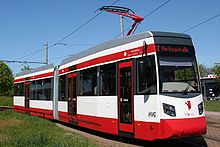
The public transport system is, among other things by the PLUSBUS of the country's network of Saxony-Anhalt provided. The following connection leads from Halberstadt:
- Line 210: Halberstadt ↔ Ströbeck ↔ Dardesheim ↔ Osterwieck ↔ Vienenburg
The Harzer Verkehrsbetriebe operates the bus services in the Harz district . To the southeast of the train station is the bus station , from which 9 lines run in the current timetable.
tram
Electric trams have been in operation in Halberstadt since 1903 , the future of which is initially secured between October 2006 and February 2007 after the renovation work on Friedrich-Ebert-Straße and the procurement of five brand-new low - floor trams of the type " Leoliner " (NGTW6-H).
The city traffic is operated by Halberstädter Verkehrs-GmbH , consisting of two tram lines and six bus lines, one of which is a so-called night bus line. The central transfer point next to the main train station is the Holzmarkt stop , which is located in the city center and where the lines meet.
Research and educational institutions
- Harz University - University of Applied Sciences (FH): Department of Administrative Sciences
- Church music seminar Halberstadt of the ecclesiastical province of Saxony
- Commercial private school Oskar Kämmer
- Retail education center
- Road traffic education center
- Martineum grammar school planetarium
Elementary schools
- Diesterweg
- Mr. from mirror
- Johann Wolfgang von Goethe
- Miriam Lundner
- Anne Frank
- Evangelical primary school “St. Laurentius "
Secondary schools
- Anne Frank
- At the Gröpertor
- Freiherr Spiegel
- Walter Gemm
High schools
- Käthe Kollwitz
- Martineum
Special schools
- Special school for people with learning disabilities "Albert Schweitzer"
- State education center for the hearing impaired
- Special school for the mentally handicapped " Reinhard Lakomy School"
Other schools
- District adult education center
- District Music School
- Music school Schicker
media
The Halberstädter Volksstimme appears as a daily newspaper . The “ General-Anzeiger ” has been distributed twice a week since 1990 . The Harzzeit is a monthly magazine for the Harzkreis, which is published by the Ideen: Gut OHG with a circulation of 120,000 copies. The same agency publishes the glossy city magazine Martini (22,000 copies) every month . The regional television broadcaster RFH is based in Halberstadt .
Religions
(see also churches )
The Evangelical Lutheran Church District Halberstadt belongs to the Evangelical Church in Central Germany . In Halberstadt, this includes the St. Stephen's Cathedral , as well as the churches of St. Johannis , Liebfrauen , St. Martini and St. Moritz, as well as the Cecilienstift chapel and the Halberstadt church music seminar. Other Protestant churches are located in incorporated towns.
The Catholic deanery Halberstadt belongs to the diocese of Magdeburg . This includes the parish of St. Burchard in Halberstadt with the parish church of St. Katharina u. Barbara , the Church of St. Andreas as well as the Catholic churches in Adersleben and Gröningen and formerly Langenstein (church now Protestant). Is at the Church of St. Andrew, a monastery of the Franciscans , and at the Church of St. Catherine. Barbara a convent of the Carmelites of the Divine Heart of Jesus .
The New Apostolic District Halberstadt belongs to the New Apostolic Church of Central Germany . The community of the same name in Halberstadt with its church on Gleimstrasse belongs to him.
The Zionsgemeinde Halberstadt belongs to the independent Evangelical Lutheran Church . The congregation meets in the chapel in the Campestift, their Zion chapel fell victim to a bomb attack in April 1945 and was not rebuilt.
The Evangelical Free Church Congregation Halberstadt ( Baptists ) belongs to the Federation of Evangelical Free Church Congregations, the Pentecostal Church Halberstadt to the Federation of Free Church Pentecostal Congregations . The Church of Jesus Christ of Latter-day Saints ( Mormons ) is also represented with a congregation in Halberstadt.
The Ursuline monastery , founded in the 17th or 18th century, existed until 1810 and was destroyed in the Second World War. The former monastery of St. Burchardi is now used for various cultural and economic activities. The medieval Siechenhof chapel St. Georg has been preserved as a ruin and has been a listed building since 1992.
The synagogue was demolished in 1938, and the last members of Halberstadt's Jewish community were deported in 1942 . The three Jewish cemeteries (see section “Jewish cemeteries” ) and, since 1995, the Moses Mendelssohn Academy and its facilities are reminiscent of Jewish history in Halberstadt .
Personalities
literature
- Klaus Militzer, Peter Przybilla: City development, bourgeoisie and council. Halberstadt and Quedlinburg until the middle of the 14th century . Vandenhoeck & Ruprecht, Göttingen 1980, ISBN 3-525-35380-4 .
- Horst Scholke: Halberstadt (= city books of art history ). 3. Edition. Seemann, Leipzig 1982.
- Berent Schwineköper (Hrsg.): Handbook of the historical sites of Germany . Volume 11: Province of Saxony Anhalt (= Kröner's pocket edition . Volume 314). 2nd, revised and expanded edition. Kröner, Stuttgart 1987, ISBN 3-520-31402-9 , pp. 169-174.
- Peter Findeisen: Halberstadt: Cathedral, Liebfrauenkirche and Domplatz . With a contribution by Adolf Siebrecht: The Domburg Halberstadt from an archaeological point of view . Recordings by Sigrid Schütze-Rodemann a. Gert Sagittarius. (= Series: The Blue Books). 4th, revised. Edition. Langewiesche, Königstein im Taunus 2009, ISBN 978-3-7845-4606-3 .
Web links
Individual evidence
- ↑ State Statistical Office Saxony-Anhalt, population of the municipalities - as of December 31, 2019 (PDF) (update) ( help ).
- ↑ https://de.climate-data.org/location/896295/#climate-table The data are based on average values between 1982 and 2012.
- ↑ Mass grave from Halberstadt reveals a new facet of Neolithic violence , press release from the State Office for Monument Preservation and Archeology Saxony-Anhalt, June 26, 2018.
- ↑ see p. 79 f. by Jürgen Udolph : Place names around Halberstadt - witnesses of history. In: History and Culture of the Diocese of Halberstadt 804-1648. Halberstadt 2006, pp. 63–90 ( PDF 1.5 MB)
- ^ MGH DD O III. No. 55, p. 460.
-
↑ Monika Lücke , Walter Zöllner : Hunting witches in the early modern period in the area of Saxony-Anhalt. In: Elke Stolze (Hrsg.): FrauenOrte, women's history in Saxony-Anhalt. Volume 1, Halle 2008, pp. 35–36.
Monika Lücke, Dietrich Lücke: witch trials in the territory of the diocese of Halberstadt. In: History and Culture of the Diocese of Halberstadt. Symposium, minutes. 2006, pp. 679-686. - ↑ Joachim Lehrmann : Justus Oldekop, fighter against the witch mania and early enlightenment. In: 1200 years of the Halberstadt diocese - Halberstadt City Museum. 2004, pp. 149-162.
- ^ H. von Franckenberg-Ludwigsdorff: Memories of the Black Corps, which Duke Friedrich Wilhelm von Braunschweig-Oels established in 1809. From a veteran's diary. Schwetschke, Braunschweig 1859, p. 21 ff. Digitized
- ↑ Friedrich Justin Bertuch : General geographical ephemeris . tape 50 . Publishing house d. Industrie-Comptoirs, Weimar 1816, p. 362 f . ( Digitized version ).
- ^ Official Journal of the Government of Magdeburg 1825, p. 4
- ^ Roger A. Freeman: Mighty Eighth War Diary . Publisher: JANE'S, London / New York / Sydney 1981, ISBN 0-7106-0038-0 , p. 483.
- ^ Report from Kontraste (RBB / ARD) from December 20, 2007 on YouTube .
- ^ History of the Soviet troops in Halberstadt. As of November 10, 2008.
- ↑ http://www.wb-online.de/halberstadt-gssd/gar7.html as of November 10, 2008.
- ↑ http://www.wb-online.de/halberstadt-gssd/gr20.html as of November 10, 2008.
- ↑ Werner Hartmann: On the history of the Halberstadt garrison and its troops 1623-1994. Volume 7, Halberstadt 2001 (2002), p. 63.
- ↑ StBA: Changes in the municipalities of Germany, see 1995
- ^ StBA: Changes in the municipalities in Germany, see 1996
- ↑ StBA: Area changes from January 01 to December 31, 2010
- ↑ census database
- ↑ www.halberstadt.de , accessed on August 19, 2017.
- ↑ City Returning Officer: Announcement of the results of the 2019 city council elections (PDF; 328 kB) In: halberstadt.de. June 5, 2019, accessed August 28, 2019 .
- ↑ 2014 election results ( Memento from July 29, 2014 in the Internet Archive ) (PDF)
- ^ Website Halberstadt: Twin Cities
- ↑ Bismarck Tower Halberstadt on bismarcktuerme.de
- ^ Dehio-Handbuch der Deutschen Kunstdenkmäler, Sachsen-Anhalt I. Deutscher Kunstverlag, Munich / Berlin 2002, p. 349.
- ↑ Harz - statistik.arbeitsagentur.de. Employment Agency, accessed on October 16, 2019 .



